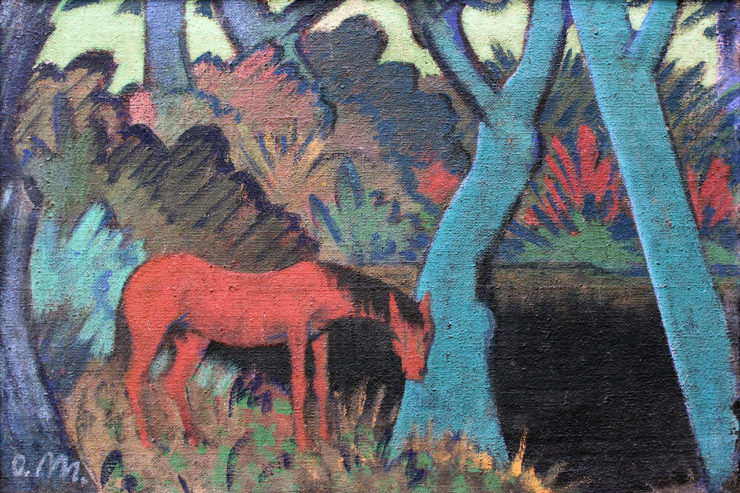There’s been a fair bit of buzz on the interwebs lately about a horse nicknamed “Docteur” Peyo. He’s fifteen years old, a former dressage competitor, and he visits terminal cancer patients in a hospital in France. Apparently it’s his decision, his owner just goes along as escort. He decides which patient he will see, by lifting a foreleg at the door. Then he spends as much time with the patient as he chooses.
Peyo is an imposing animal. He’s big, as competition dressage horses often are, and he’s a stallion, with a truly impressive neck (which is one of the secondary sexual characteristics of an intact male horse). He looks like one of the horses of San Marco, or a Baroque equestrian portrait. And yet he’s wonderfully gentle.
Much of the buzz about him has been focused on how he’s unique and unusual and there may be something different about his brain. Articles that I’ve seen don’t seem to recognize that therapy horses are not particularly rare; like other therapy animals, they often visit hospitals and nursing/care homes. Nor is it only miniature horses or ponies. One of my former neighbors in Tucson has done care visits for decades with a succession of carriage horses including a couple of Clydesdales from the Budweiser herd. The first of those would have dwarfed Peyo. He was 2000 pounds of pure gentleness.
I personally would like to see broader studies of therapy horses worldwide, to see if Peyo really is a cut above, or if he fits into more of a spectrum of horses as healers. According to his owner/companion, Hassen Bouchakour, he started his career at dressage shows, when he would single out a spectator and want to spend time with them, and that person was always ill either physically or mentally. Eventually Bouchakour decided to concentrate on the horse’s talents as a healer, particularly in the oncology section of the hospital in Calais.
Bouchakour is rather an exceptional person himself, to see the horse’s gifts and turn them into a mutual calling. He’s doing a thing that horse people are doing more and more, letting the horse decide what his life’s work will be. For Peyo, that’s attending humans at the end of life.
Some commenters have compared Peyo to Oscar the Death Cat, who made a point of visiting patients who were just about to die. It got so the staff at the facility would see him on a patient’s bed and know that patient was ready to go. Peyo seems to have a similar gift for knowing when a human is close to the end.
Conceptually there’s a big difference between a little fluffy cat and a huge imposing horse. And yet they’re both remarkably keyed in to humans who need them. This ability to connect with a human, this tendency to form a bond that may last through life and even to death, is characteristic of horses who are socialized to humans. Horses have an aura about them, a sense of calm and peace. There’s nothing else quite like it.
Buy the Book


A Spindle Splintered
The comments on the Guardian article about Peyo and its twitter feed took a direction that unfortunately happens all too often on the internet. They went negative, and they piled on fast. Commenter after commenter ranted about this horrible terrifying hideous beast. How dare this awful creature invade the hospital rooms of the dying? Spare me, they said. Keep him away from me. I’d be literally scared to death.
I did not engage, because I am old in internet years and I do not waste time in that fashion. But all I could think was, “Bless your heart, honey. He wouldn’t choose you.”
Peyo selects people who need what he has to give. For those who love horses, however much or little experience they may have with actual live equines, there is nothing more comforting than that big, warm, breathing presence. To see that shape looming over you, to smell the sweetness of his breath, to be able to touch that silken coat or that velvet nose, truly does make those last hours a little easier.
Dogs and cats are much more portable and much simpler to bring in—my own dog did that for my mother when she was in hospice; she’d ask me to bring him when I visited—but for those who love horses, it’s a genuine gift to see one in that of all places. Horse people need to be around horses. When they’re separated from them, it’s actually painful.
Peyo brings that to the terminal patients in Calais, and to their families, too. So do many others like him around the world. There’s even a facility in Tucson that has built itself around equine therapy.
As I said, horse people need horses. I might even say that people need horses, if they’re not all tangled up in fear and negativity. That calm, that gentle presence, can do so much to heal what ails a human.
And horses seem to need to give that, too. That’s the basis of therapeutic programs for humans with all sorts of diagnoses, both physical and psychological. Like Peyo, therapy horses do what they do willingly. Even horses that haven’t been specifically trained for it will be remarkably gentle with humans who need them. It’s a big part of what they are.
Judith Tarr is a lifelong horse person. She supports her habit by writing works of fantasy and science fiction as well as historical novels, many of which have been published as ebooks. She’s written a primer for writers who want to write about horses: Writing Horses: The Fine Art of Getting It Right. She lives near Tucson, Arizona with a herd of Lipizzans, a clowder of cats, and a blue-eyed dog.










